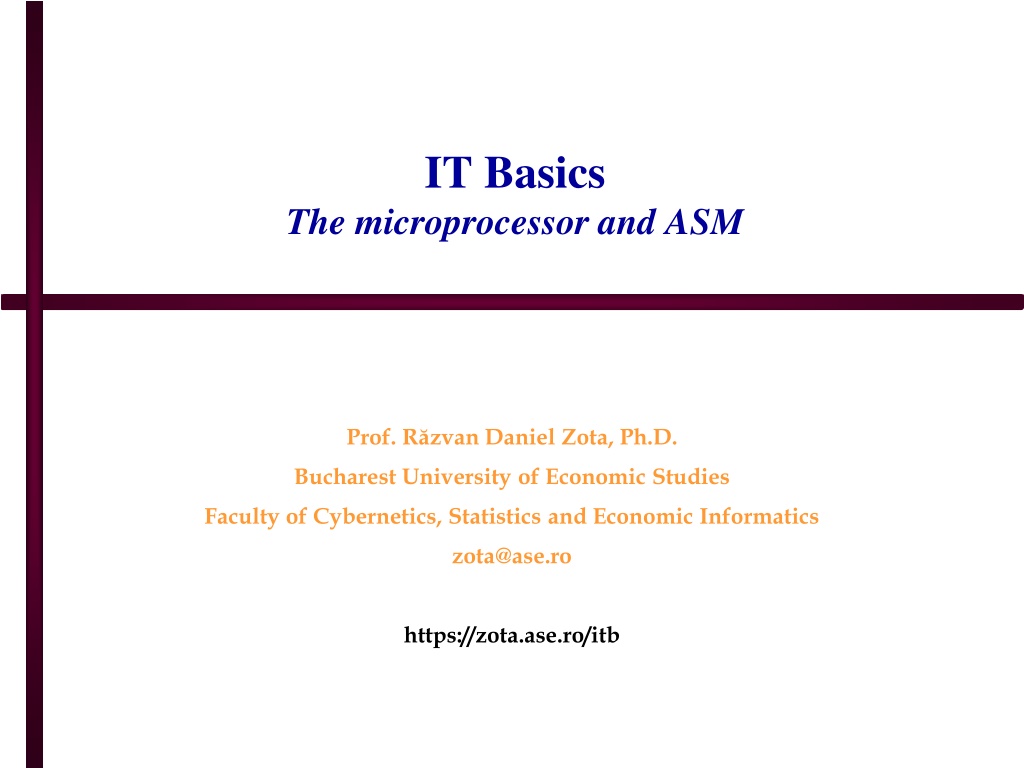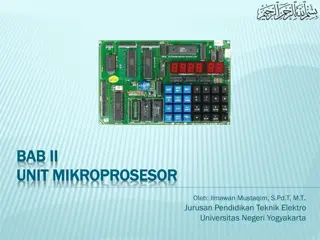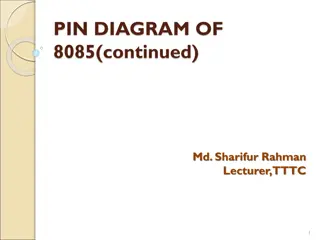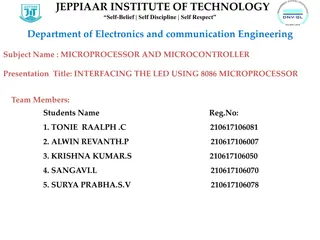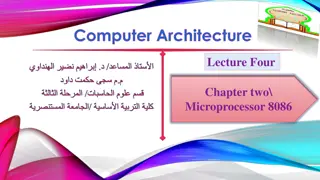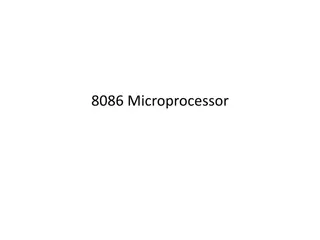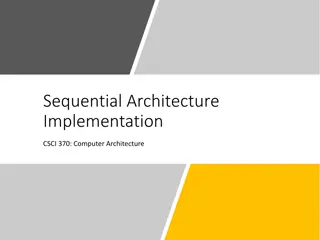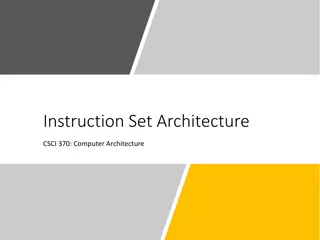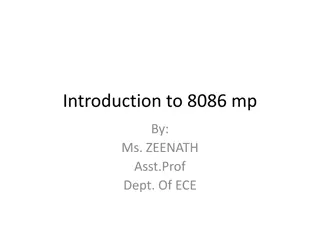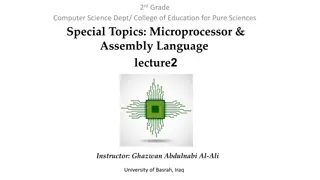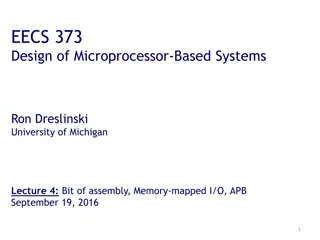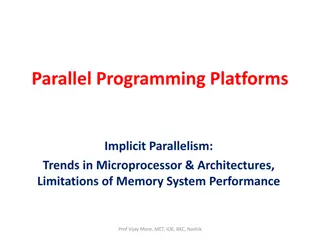Understanding Microprocessor Architecture and Instruction Processing
Explore the basic architecture of a microprocessor, including CPU registers, memory locations, and instruction processing steps. Learn about Intel microprocessor components, addressing modes, and the operation of pipeline microprocessors. Understand the role of control units, ALU, and bus interfaces in executing instructions effectively. Dive into the X86 system architecture and the function of address, data, and control buses in memory and I/O operations.
Download Presentation

Please find below an Image/Link to download the presentation.
The content on the website is provided AS IS for your information and personal use only. It may not be sold, licensed, or shared on other websites without obtaining consent from the author. Download presentation by click this link. If you encounter any issues during the download, it is possible that the publisher has removed the file from their server.
E N D
Presentation Transcript
IT Basics The microprocessor and ASM Prof. R zvan Daniel Zota, Ph.D. Bucharest University of Economic Studies Faculty of Cybernetics, Statistics and Economic Informatics zota@ase.ro https://zota.ase.ro/itb
Contents Basic microprocessor architecture Intel microprocessor registers Instructions their components and format Addressing modes (with examples) 2
Basic microprocessor architecture CPU registers Special memory locations on the microprocessor chip Examples: accumulator, counter, FLAGS register Arithmetic-Logic Unit (ALU) The place where most of the operations are being made inside the CPU Bus Interface Unit (BIU) It controls data and address buses when the main memory is accessed (or data from the cache memory) Control Unit and instruction set The CPU has a fixed instruction set for working with (examples: MOV, CMP, JMP) 3
Instructions processing Processing an instruction requires 3 basic steps: 1. Fetching the instruction from memory (fetch) 2. Instruction s decoding (decode) 3. Instruction s execution (execute) implies memory access for the operands and storing the result Operation mode of an antique Intel 8086 Decode 1 Execute 1 Decode 2 Execute 2 Fetch 1 Fetch 2 Microprocessor ... Bus Idle Busy Idle Busy ... Busy Busy 4
Instructions processing Modern microprocessors may process more instructions simultaneously (pipelining) Operation of a pipeline microprocessor (from Intel 80486 to our days) Fetch 2 Fetch 3 Fetch 4 Store 1 Fetch 5 Fetch 6 Read 2 Fetch 7 Fetch 1 Bus Unit Decode 1 Decode 2 Decode 3 Decode 4 Decode 5 Decode 6 Instruction Unit Idle Idle Execute 1 Execute 2 Execute 3 Execute 4 Execute 5 Execute 6 Execution Unit Idle Generate Address 1 Generate Address 2 Address Unit 5
X86 Basic System Architecture A19 Address Bus gives a memory address to the system and a I/O address to I/O system equipment Address Bus A0 8086 System D15 Data Bus transfers the data between the microprocessor, memory and I/O equipment attached To memory and I/O Data Bus (16 bit) D0 Control Bus RD/WR Memory I/O Control Bus is generating control signals derived from a I/O operation 6
Data and memory address dimensions Processor Data Bus Address Bus Maximum addressing memory 8088 8 20 1,048,576 (1MB) 8086 16 20 1,048,576 (1MB) 80286 16 24 16,777,21 (16MB) 80386dx 32 32 4,294,976,296 (4GB) 80486 32 32 4,294,976,296 (4GB) 80586/Pentium (Pro) 64 32 4,294,976,296 (4GB) Intel/AMD 64 bit 64 40 1,099,511,627,776 (1TB) http://www.tomshardware.com/reviews/processor-cpu-apu- specifications-upgrade,3566-2.html 7
Microprocessors registers Obs: 32 bit registers do not appear for 8086, 8088, 80286 8
General purpose registers 32 bi i AX AH Accumulator AL EAX BX EBX Base Index BH BL 16 bi i CX CH Counter CL ECX DX EDX Data register DH DL Obs: 32 bit registers do not appear for 8086, 8088, 80286 9
General purpose registers 16 bi i SP Stack pointer ESP BP EBP Base pointer DI EDI Destination index SI ESI Source index Obs: 32 bit registers do not appear for 8086, 8088, 80286 10
General purpose registers AX (accumulator) The AX register usually contains the result obtained from a arithmetic/logic operation (see also EAX, AH, or AL) BX (base) The BX register usually contains the base address (offset) of the data in memory (see also EBX, BH, BL) CX (count) The specialty of the CX register is counting. It plays the counter role for some specific instructions (see LOOP instruction). DX (data) The DX register has some specific properties correlated with multiplying and dividing, such as: It contains the most significant part of the result in case of multiplying two numbers on 16 or 32 bits; It contains the most significant part of the divider before the division; It contains the I/O port for some I/O instructions 11
Pointer and index registers SP (stack pointer) The least general , used to address data in a memory region of LIFO (last-in, first-out) type: the stack. It is modified in the following cases: As a result of PUSH and POP instructions; A sub-routine CALL or a return (RET) from a sub-routine of a program; Some system resources (the keyboard or internal clock) are using the stack when they interrupt the microprocessor. BP (base pointer) Used to address a data array in the stack (it is referring to SS-stack segment) SI (source index) can be used to address indirectly data DI (destination index) same as SI IP (instruction pointer) It is always used to point to the next instruction to be execute by the microprocessor 12
The stack Stack segment Base of stack (initial value SP or ESP) The POP instruction determines moving the top of the stack to a higher memory address Local variables for the called procedure The parameters of the called procedure The PUSH instruction determines moving the top of the stack to a lower memory address Return Instruction Pointer BP (EBP) register SP (ESP) register Top of stack The BP register it is set up to make a reference to the memory address for returning from the procedure 13
Stack example At the beginning: ? BX ? ? ? 996 ? 998 CX 1000 1000 SP After MOV BX, 9 and PUSH BX: 9 BX ? 9 ? 996 ? 998 CX 1000 998 SP After MOV CX, 10 and PUSH CX: 9 BX 10 9 ? 996 10 998 CX 1000 996 SP 14
Stack example After POP BX: 10 BX ? 9 ? 996 10 998 CX 1000 998 SP After POP CX: 10 BX ? ? ? 996 9 998 CX 1000 1000 SP 15
FLAGS register FLAGS register O D I T S Z A P C O - Overflow Flag D - Direction Flag I - Interrupt Flag T - Trap Flag S - Sign Flag Z - Zero Flag A - Auxiliary Carry Flag P - Parity Flag C - Carry Flag 16
FLAGS register A flag is a bit that identifies the current state of the microprocessor and its operating mode The flags are being modified after the execution of some arithmetic or logic instructions Examples: C(carry) flag it identifies the appearance of a binary carry bit in case of an addition or a borrow in case of a subtraction O(overflow) flag it is modified after an arithmetic operation. If it is set (of value 1) it means that the result doesn t fit the destination operand Z(zero) flag it means that the result of an arithmetic or logic operation is zero 17
FLAGS register S(sign) flag it shows the result of an arithmetic operation D(direction) flag when it is zero the processing of the elements is being made from the lower to the upper address and vice versa in the other case I(interrupt) flag - it controls the possibility to respond to extern events (interrupt calls) T(trap, trace) flag - used by the debugger programs, activating or not the possibility to execute the program step by step. If it is set, the CPU interrupts each instruction, leaving the debugger to execute the program step by step 18
FLAGS register A(auxiliary carry) flag it supports BCD operations. P(parity) flag it is set if the result of an operation contains an even number of 1 bits. If the number of 1s is odd, then PF=0. 19
Segment registers, IP and FLAGS 32 bits IP IP EIP Flags EFlags FLAGS 16 bi i CS Code segment register Data segment register DS SS Stack segment register ES Extra segment register FS Additional register (80386, 80486+) GS Additional register (80386, 80486+) 20
Segment registers CS(code) The code register contains the address for the start of the part of memory which contains the code of the program DS(data) The data register contains the address for the beginning of the region of memory which contains data ES(extra) Additional segment register SS(stack) It defines the region of memory used by the stack. The stack pointer register contains the address for the top of the stack The BP register contains the address for the data inside the stack FS and GS available beginning with 80386 and 80486 additional registers used to access memory segments 21
Code machine language The code machine language represents the native binary code which is understood by the microprocessor, containing instructions for its operation From the assembler program the code machine is generated The code machine instructions for 8086-80486 varies from 1 to 13 octets There are over 20.000 variations of machine code The real mode use 16 bits instructions There are used 16 bits offset addresses and 16 bits registers 22
Code machine language (cont.) The protected mode may use instructions on 16 or 32 bits The D bit from the descriptor it shows the way 80386/80486 instructions are using the registers and data from memory in the protected mode D = 0 means 80386/80486 16 bits instructions D = 1 means 80386/80486 32 bits instructions The working mode with 32 bits instructions means that both offset addresses and registers are on 32 bits. 23
Addressing modes Using registers copy a byte or a word from the source register to the destination register MOV BX, CX Effective copy an effective value (byte or word) from a memory location to a destination register MOV AX, 3456h Directly copy a byte or a word from a memory location specified by a register segment) MOV AL, [1234h] (1234h represents the offset in the data 24
Addressing modes(cont.) Indirect by registers (indexed) copy a byte or word from a memory location addressed by an index register (DI or SI) or a base register (BP or BX) in a register: MOV AX, [BX] Base plus index (relatively to the base indexed) -copy a byte or word from a memory location specified by a base register (BP or BX) plus an index register (DI or SI) in a register: MOV DX, [BX + DI] 25
Addressing modes(cont.) Register relative - copy a byte or word from a memory location addressed by an index register (DI or SI) or a base register (BP or BX) plus an offset to a register: MOV AX, [BX + 1000h] Base relative plus index (base relative indexed) copy a byte or word from a memory location specified by a base register (BP or BX) plus an index register (DI or SI) plus an offset, into a register: MOV AX, [BX + SI + 100h] 26
Instruction rules Each instruction can access memory only once: MOV var1,var2 is not a valid instruction MOV AX,var2 followed by MOV var1,AX is correct. For instructions with two operands their dimensions must be the same: We may compare an 8 number with another 8 bit number We may compare an 16 number with another 16 bit number CMP AH,AX is not a valid instruction The destination operand (normally, the left one) must identify a register or a memory location: MOV 1234,AX is not valid The Mode byte identifies what registers will be used by an instruction 27
Instruction components and format Data/ Effective value Opcode Mode Displacement Instruction s components: 31
Instructions components Data/ Effective value Opcode Mode Displacement The Opcode byte represents the operation code, the direction (D) and dimension (W) D W Mode appears only for instructions that are using registers OPCODE The Mode byte represents the destination and source for the instructions with two operands The destination and source are specified by the REG and R/M fields MOD REG R/M 32
Opcode Opcode (1 or 2 bytes) is selecting the operation (addition, subtraction, move, etc.) to be executed by the microprocessor D (direction) identifies the sense of the operation D = 0 - from REG to R/M D = 1 - from R/M to REG D W W data s dimension W = 0 - byte W = 1 word or double word OPCODE 33
Mode offset Mode byte has 3 components Mod specifies addressing type for the instruction with or without MOD REG R/M Mod Function 00 01 10 11 No displacement 8 bits displacement 16 bits displacement R/M is a register In the case when Mod field contains one of the values 00, 01 or 10, the R/M filed is selecting one of the addressing modes, such as: MOV AL, [DI] (no displacement) MOV AL, [DI + 2] (8 bits displacement) 34
REG and R/M values Code W = 0 (Byte) W = 1(Word) W =1 (Double Word) 000 001 010 011 100 101 110 111 AL CL DL BL AH CH DH BH AX CX DX BX SP BP SI DI EAX ECX EDX EBX ESP EBP ESI EDI 35
Example Let consider the instruction 8BECh on 2 bytes in binary (assume working on 16 bits) Binary representation: 1000 1011 1110 1100 Results: OPCODE: 100010 => MOV D = W 1 => One word is copied in the register specified in the REG field MOD 11 => R/M identifies the register REG 101 => BP register R/M 100 => SP register In conclusion, the instruction to be executed is: MOV BP, SP 36
Example using R/M In the case when Mod contains one of the values 00, 01 or 10, the R/M field has a new significance Example: 1. If Mod = 00 and R/M = 101 the addressing mode is [DI] 2. If Mod = 01 or 10 and R/M = 101 the addressing mode is [DI + 33h] or [DI + 2222H], where 33h and 2222h are arbitrary values for the offsets Code Function 000 001 010 011 100 101 110 111 DS:[BX+SI] DS:[BX+DI] SS:[BP+SI] SS:[BP+DI] DS:[SI] DS:[DI] SS:[BP] DS:[BX] Base plus index Indirect register 37
Example Let have the instruction 8A15h in machine code Binary representation is: 1000 1010 0001 0101 OPCODE: D W MOD REG R/M 100010 1 0 00 010 101 => MOV => A word is copied to the register specified by the REG field => Byte => Memory without displacement => DL register => Addressing mode [DI] In conclusion, the instruction is: MOV DL, [DI] 38
